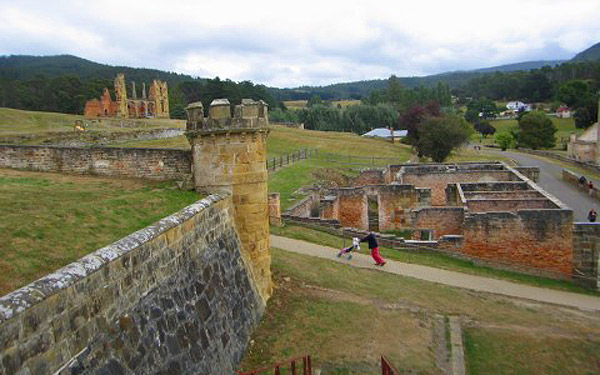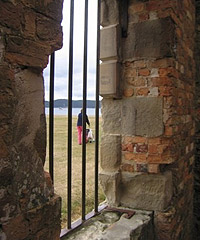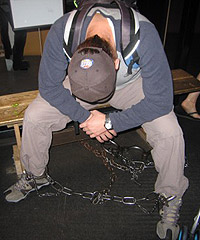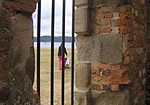
Port Arthur: fascinating tourist attraction, lousy place to push a stroller.
When you’re living in a youth hostel with a toddler, even the smallest things become complicated operations. Take bathing, for example. We’re currently sharing bathrooms with the rest of our floor, and you kind of need your own bathroom with a little one, so we’re forced to get creative.
After much deliberation, we decided the most effective course of action was for Hannah to go in the shower with Sarah, who got her clean while I waited outside the women’s bathroom door with a towel. After my ten minutes of playing the Creepy American Guy Loitering Outside the Women’s Bathroom in a Tasmanian Youth Hostel, a naked Sarah appeared to hand off our slippery, confused kid to me. I took the kid back to our room while Sarah stepped back into the shower. Over the course of our trip, this tactic became known as the “Hobart Maneuver.” We perfected it.
* * *

In a bizarre turn of events, my vacation ended with incarceration. Bummer. |
Today we took a 60-mile catamaran cruise to Port Arthur. Our ship was cushy—by far the most luxury we’ve experienced in weeks—and we were pampered with muffins and tea and comfy seats for two and a half hours. But there was a price to be paid, and that price was the morose captain’s periodic guilt-trip announcements on the loudspeaker:
“Aren’t these waters beautiful? Pity that whaling is destroying them.”
“Ugh, look at the size of that ship. Why would anyone want to sail on a beast that big?”
“It’s the Japanese. They kill countless sharks just for their fins!”
When we weren’t hanging our heads, we saw schools of dolphins hopping in and out of the bay, cliffs and islands with caves and horizontal rocks, more of the toughest surfing breaks in the world. Perhaps the highlight was when we passed directly in front of a large group of seals sunning themselves on rocks and diving in the water. “There used to be more seals,” Captain Killjoy said.
Our destination, Port Arthur, was a fascinating place. A notorious 19th century penal colony 60 miles from Hobart, the place is rife with tales of infamy and cruelty. One web site’s description: ” . . . prisoners living under threat of the lash and an experimental isolation system which often drove them to madness.” If they stuck you in Port Arthur, you really screwed up. We learned about various convicts and saw where they lived and worked and prayed and ate and shat.
 |
Port Arthur also happens to be stunningly beautiful. The grounds, I’m told, look a lot like they did back when lowlifes populated them: an idyllic fountain, manicured gardens, rolling hills and lawns, endless blue skies, English oaks. It ain’t Joliet. The three of us spread out a blanket and had a peaceful picnic of fruits and cheese on the green grass behind the barracks, a scene so postcard-y that other tourists snapped pictures of us.
If I were going to be incarcerated, this is where I’d want it to be. I tried on some leg irons, which were considerably more comfortable than I’d expected.
It’s hard to imagine now, but Port Arthur was also the site of a 1996 massacre where a crazed 28-year-old murdered 35 people and wounded 37 more. Mowed them down in a gift shop, a restaurant, a parking lot, and pretty much everywhere else on the grounds. It remains Australia’s worst mass-killing spree. The scale of the nightmare is tough for outsiders to understand, and understandably, no one likes to talk about it today, but the shadow of tragedy still hangs over the place.
In their usual cheerful way, locals try to carry on: The restaurant at the visitors’ center is now called Felons. No one ever accused the Tassies of lacking a sense of humor.





